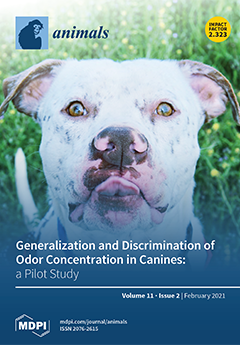Maine-Anjou × Angus cross-bred steers (
n = 156 steers; initial body weight (BW) 366 ± 37.2 kg) were used in a 132 d finishing study conducted at the Ruminant Nutrition Center (RNC) in Brookings, SD. Steers were blocked by weight (
n = 5 BW blocks) and randomly assigned to an implant and dietary treatment of a randomized complete block design with each pen containing seven to eight steers (
n = 20 pens). Dietary treatments consisted of (1) 15% (CS15) or (2) 30% corn silage (CS30) where corn silage displaced corn grain in the diet. Steers received one of two implants (both from Zoetis, Parsippany, NJ) containing equal doses of trenbolone acetate (TBA) and estradiol benzoate (EB): (1) Synovex PLUS (non-coated implant; 200 mg TBA and 28 mg EB; PLUS) or (2) Synovex ONE Feedlot (coated implant; 200 mg TBA and 28 mg EB; ONE-F). Bunks were managed using a slick bunk approach, and all diets contained dry matter (DM) basis 33 mg/kg monensin sodium. All steers were offered
ad libitum access to feed, and feeding occurred twice daily in equal portions. There was no interaction between the implant and dietary treatment for any variables measured (
p ≥ 0.08). Carcass-adjusted basis final BW, average daily gain (ADG), and grain to feed (G:F) were increased (
p ≤ 0.02) by 2.2%, 6.5%, and 7.2%, respectively, for CS15. Observed net energy (NE) and the ratio of observed-to-expected NE for maintenance and gain was not influenced (
p ≥ 0.15) by silage inclusion treatment. Beef production per hectare was not impacted (
p ≥ 0.13) by corn silage inclusion level. Fecal output was increased, and digestibility coefficients for dry matter, organic matter, and crude protein were decreased in CS30 (
p ≤ 0.03). Dressing percent and hot carcass weight (HCW) were greater (
p ≤ 0.02) in CS15. Implant type did not influence any traits measured (
p ≥ 0.14) except for marbling. Marbling was decreased for PLUS (433 vs. 466 ± 17.5;
p = 0.02) compared to ONE-F steers. Similar beef produced per hectare of crop land-based upon silage feeding level means producers can feed greater inclusions of corn silage to finishing cattle without impacting carcass quality or beef production; implanting with a coated implant had no detrimental effects to growth performance but increases marbling scores.
Full article






